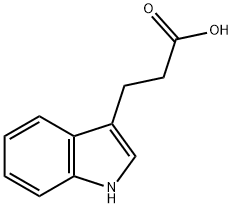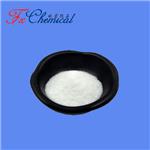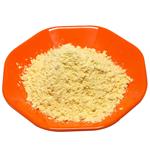Description
Indole-3-propionic acid is a bacterial metabolite that has antioxidant and neuroprotective activities. It scavenges ABTS radicals in a cell-free assay when used at concentrations ranging from 50 to 150 μM and decreases hydrogen peroxide-induced malondialdehyde (MDA) levels in rat striatal membranes (IC
50 = 180 μM). Indole-3-propionic acid also decreases increases in MDA levels induced by amyloid β (1-42) in PC12 cells. It decreases ischemia-induced increases in cell death of pyramidal neurons and levels of 4-hydroxy nonenal (HNE; ) and glial fibrillary acidic protein (GFAP) in the hippocampal CA1 region in gerbils when administered at a dose of 10 mg/kg per day.
Chemical Properties
pale yellow to yellow crystalline powder
Uses
Reactant for preparation of:
- Fluorescent analogues of strigolactones
- Anti-tumor agents
- Melanocortin receptors ligands
- Immunosuppressive agents
- Iinhibitors of hepatitis C virus
- Histamine H4 receptor agonists
- NR2B/NMDA receptor antagonists
- CB1 antagonist for the treatment of obesity
- Antibacterial agents
- Inhibitor of TGF-β receptor binding
Indole-3-propionic acid may be used in the synthesis of oxindole-3-propionic acid via reaction with
N-bromosuccinimide in acetic acid followed by treatment with H
2/Pd catalyst.
Uses
3-Indolepropionic acid is a deamination product of Tryptophan (T947200) that protects the hippocampus (studied in gerbils) from ischemic damage and oxidative stress. It’s ability to protect the neurons in this way is attributed to its potent antioxidative effects. 3-Indolepropionic acid is also hypothesized to have protective effects on the thyroid gland.
Definition
ChEBI: An indol-3-yl carboxylic acid that is propionic acid substituted by a 1H-indol-3-yl group at position 3.
General Description
3-Indolepropionic acid is an effective inhibitor of aggregation of misfolded β-amyloid protein (Abeta). Three-component one-pot procedure has been reported to assemble 3-indolepropionic acids.
Biochem/physiol Actions
Studied as an adjunct to improve perfusion after liver transplant.
Purification Methods
Recrystallise it from EtOH/water [James & Ware J Phys Chem 89 5450 1985]. The picrate has m 143-144o, and the methyl ester crystallises from *C6H6 or MeOH with m 81-83o. [Beilstein 22 III/IV 1113, 22/3 V 114.]




